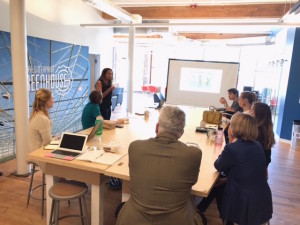This week’s Brown Bag Lunch workshop here at the SEG Hub brought us Michelle Saunders, Manager of Organizational and Leadership Development of Ocean State Job Lot. Michelle is a Providence native who has a history of facilitating discussions about diversity and inclusion across Rhode Island. She led a talk which touched on a broad range of issues, from what diversity means to managing employee turnover. Here are 5 things I learned from this workshop.
1. Definitions are slippery. So, what is inclusivity anyway? It means different things in different times, places and contexts! But for the purpose of this talk it means looking around at the people in your community, looking around at the people in your business. It means asking “does my workplace reflect the community?” And trying to bring these into alignment. Michelle asked us to share our personal goals and definitions, and you might consider that in your own workplace, too.
2. Who are we doing this for? When we include someone, we may have framed ourselves as the WE who is doing the including. Michelle says “It shouldn’t be about ‘Oh, it’s going to help these poor people.’” It’s time to set aside the false binary of privileged people in power giving access to the disadvantaged solely for their benefit. Inclusivity can benefit everyone, and all people have something to bring to the table. Perhaps it is a different way of thinking, an under-represented perspective or cultural insight. People are valuable because all humans matter, not just for an increase in “diversity numbers”.
3. Increase in conflict management. When people from different backgrounds come together, each bringing their own outlooks and ideas, there may be more potential for conflict compared to a homogenous population. “From a human resources perspective, you need to be mindful of workplace discrimination such as bullying and interpersonal conflict.” But what if we can view this as an opportunity? Rather than avoiding diversity due to a fear of conflict, we might come up with a plan to help us all to learn and grow. At times, a neutral party may help to mediate. Here are some conflict resolution resources:
https://hbr.org/2007/11/how-to-manage-conflict
https://www.pon.harvard.edu/daily/conflict-resolution/conflict-resolution-strategies/
http://jbsq.org/wp-content/uploads/2015/03/March_2015_2.pdf
4. Information-gathering vs. Action plan. They need each other! Talking is great. Doing research is great. Writing a diversity statement makes sense. “You have to set some norms,” says Michelle. And then comes the action! Creating a statement does not, all by itself, solve anything. Take actual steps to achieve the goals. Our words are strengthened by accountability, especially over time. This is a process, and it won’t be achieved by having one meeting, and that is OK.
5. Micro-messages. So you’ve created an inclusive workplace–congratulations! You’ve got different types of people working together, what’s next? Examining unconscious bias! Humans are wired to act, thanks to eons of summing up threats in the landscape. “Before you act, think,” Michelle says,” Slow down your amygdala.” We might ask ourselves what messages we are sending through our language and our behavior, then focus on micro-inclusions. We can, over time, train ourselves to use our body language, words and actions to send messages of inclusion and belonging to each other. First, notice our emotions and how we subtly express them. Next, actively convey the message we want to send. This can help to increase employee engagement and customer retention, help people to feel safe participating and build relationships.
Traci Picard
Venture Development Assistant
Traci Picard is a VISTA serving as Venture Development assistant here at SEG. She comes from the world of alternative health, running a small herbal business and teaching classes like Critical Thinking for Herbalists and Asking Better Questions. Traci is also a writer pursuing a Journalism degree, a mother of 3 and a passionate fan of books and the Public Library. Born in Providence, she has lived all over but continues to return home.
Contact: tpicard@segreenhouse.org


